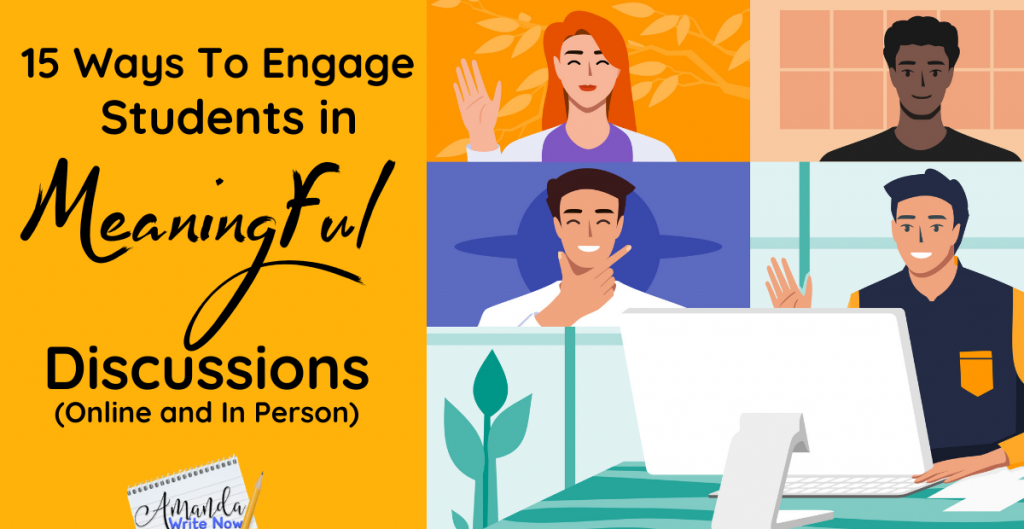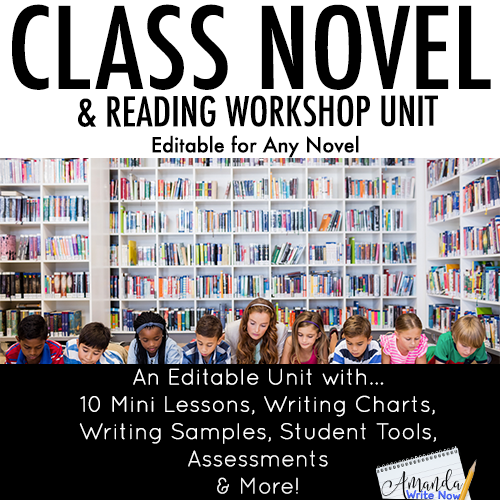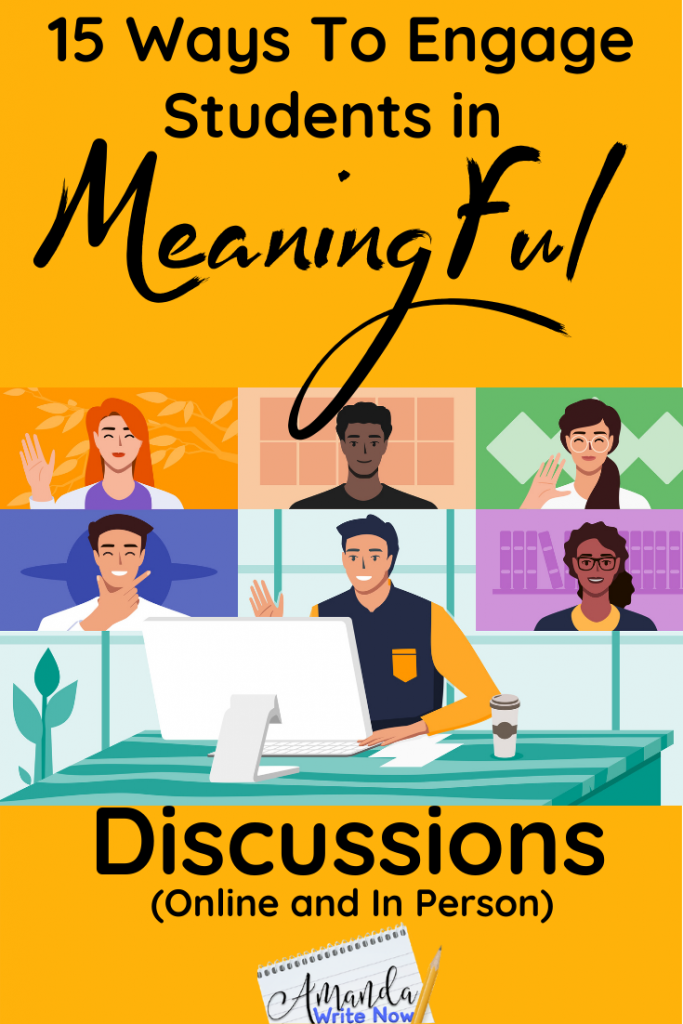
There are so many discussion tech tools available to teachers these days! Parlay, Jamboard, Back Channel, Voxer and even Google Slides and Docs can be used to facilitate discussions among students virtually.
But, what always gets me thinking is…these tools are great, but how do we get students to actually have meaningful conversations with each other? You know what I’m talking about, a real conversation…not the fake kind, where everyone is trying to compete to impress the teacher and get a good grade.
Getting students to have meaningful discussions isn’t as hard as you might think.
It’s important to remember that students are more likely to engage in discussions when:
-
They care about the topic being discussed.
-
They have background knowledge about the topic being discussed.
-
They feel safe to speak their true opinions.
-
They feel valued by the classroom community.
So, how do we accomplish all of this when we are teaching online? How do we figure out what students care about and connect that to the content we are teaching? How do we make sure they have the appropriate background knowledge. Well, that’s what this blog post will go into! I’ll provide you with the tools you need to engage your students in meaningful discussions for each of the four categories above.

Find Out What Students Care About
1. Survey Students Regularly with Google Forms
One of the most time effective ways to get to know large groups of students individually, when teaching online is through online surveys. Here are some questions you might consider adding to the next Google Form you give students:
- What is your favorite activity outside of school?
- What is your favorite subject, why?
- Do you enjoy reading? Why or why not?
- Do you enjoy writing? Why or why not
- What’s stressing you out most right now? Be specific.
- What brings you joy?
You can then share the results of your surveys as a jumping off point for discussions. You might also want to use the results to find articles related to the most popular topics and answers brought up by the surveys.
2. Allow Students to Ask the Questions
Before you let students write questions, you need to teach types of questions. I like to teach two types: open questions and closed questions. Open questions aren’t easily answered and often involve sharing opinions. Closed questions are usually questions that can be found quickly and check for comprehension.
Once you’ve taught these types of questions to your students, have them write their own open and closed questions about the class novel you are reading, their book club books, an article or even a controversial issue.
Urge students to ask open questions they care about, that they really want to hear their classmates’ answers to!
This takes time and practice. Some questions fall flat and that’s okay! Let students in on this reality, they will appreciate you for it.
3. Let Students be the Experts
Ever been to a conference with a panel of experts that the audience asked questions of? Why not simulate this experience in the classroom, virtually? Here’s how this might work…
First, survey students on areas where they are an expert. Video games, creating YouTube videos, rap music, skateboarding, it all counts! Then, create groups of 3-5 students based on expert areas. Finally, have students come up with questions they want to ask these expert panelists and let the fun begin!
4. Discuss Controversial Issues
It’s important that we give students space to learn about and discuss current events and issues. This can be uncomfortable for teachers who are afraid of getting too political. The thing is that you don’t have to share your opinions as the teacher. All you have to do is provide students with articles and information to read and allow time for students to respond via writing and discussion.
When we do this we need to provide clear ground rules. I love this Parlay my friend Amanda over at Mud and Ink Teaching created that has some beautifully written and clear ground rules. Scroll down to the section titled “Peer Feedback Instructions” to see the ground rules she sets for the discussion.
5. Read and Discuss Modern Literature (Young Adult Novels)
Many schools and teachers are stuck with the same traditional novels they’ve taught year after year. But, there is a whole world of Young Adult Literature that students develop deep connections to! Check out my favorite novels to teach by clicking here: book club: Engaging YA Books by Lexile Level and Grade.
Provide Background Knowledge
6. Read These Two Important Books
Recently, I read two books that really opened my eyes to the lack of background knowledge we are providing students in our education system. I highly recommend all educators read these two books: 7 Myths of Education by Daisy Christodoulou and The Knowledge Gap Natalie Wexler. These two authors argue that the reason students struggle with reading in particular is because students lack the background knowledge to fully comprehend texts given to them during state tests, in high school, college and beyond.
Both Christodoulou and Wexler make the case that schools focus way too much time on teaching skills such as making connections, predictions, visualizing, making inferences etc. and too little time on talking about the actual content within the texts we are having students read. The same could be said for the things we focus on during discussions…
Often, teachers (myself included) focus on the number of times a student speaks during a discussion or whether or not they added onto an idea or asked a question of their classmates. Are these really the things we should focus on during discussions? Maybe…because it’s easily evaluated. But, maybe we are putting too much emphasis on these aspects of a discussion when what we should really be focused on is the topic being discussed and the ideas students bring up.
The next three engagement ideas I have for building students’ background knowledge so that they feel confident in their abilities to participate in a class discussion:
7. Provide Text/Media Sets
When you teach a whole class novel, do you just read the novel or do you bring in other sources of information? I believe it’s important to bring in videos, primary resource documents and articles pertaining to the time period the book was written, the author and the topics and themes brought up in the book. Students will get so much more out of a book if they learn about the context of that book. Here’s an example of a media/text set for the book Chains by Laurie Halse Anderson:
Interview with Laurie Halse Anderson
8. Article of the Week
Students can’t discuss if they feel uninformed. Students who don’t have enough background knowledge will feel insecure and are more likely to avoid participating fully in the discussion! So, it’s essential we provide students with enough background knowledge about the topic before the discussion. Kelly Gallagher has a wonderful page on his website where he posts articles he uses in his classroom along with writing prompts to help students begin to write about what they learned and thought about the article. Check this page out here: Article of the Week.
9. Graph of the Week
Turner’s Graph of the Week was inspired by Kelly Gallagher’s Article of the Week. It’s awesome because there’s a whole archive of graphs for teachers to use in their classrooms. The graphs also have associated questions and space for students to respond. Check this resource out here: Graph of the Week.
10. Make Discussions Low Stakes
We don’t have to grade discussions and actually, it’s better if we don’t! Rather, have students participate in reflections about how the discussion went. If you absolutely have to grade a discussion, make sure to give students opportunities to participate in practice discussions first.
Provide a Safe Space to Speak
11. Start with Small Groups
Students will definitely get more air time when you start with small group discussions. Introverted and more shy students need this air time! There is also a lot less pressure when students are speaking in a small group rather than in front of the whole class. When teaching virtually, you are going to have to let go a little bit since you can’t be present in every break out room.
One way you might hold students accountable is by having one student in the breakout room take notes about what is said during the discussion. You might even consider having one student record the discussion for you while they are in the breakout room. This doesn’t necessarily mean you have to listen to the discussions. The act of recording may help students feel like they are being held accountable in some way. Also, platforms like Parlay allow you to assess student participation, which is awesome!
12. Change Up How You Discuss
Have you ever tried a silent discussion? What about a method called World Cafe? Hot Seat? I love The Big List of Discussion Strategies that includes an amazing number of creative ideas for facilitating discussions. When you change up the way in which you discuss you are allowing more opportunities for a wide variety of students to participate, including your introverts!
Make Students Feel Valued
13. Use Sentence Stems
Sometimes students need a nudge from us to be kind to each other. Sentence stems are the perfect way to give students that nudge. Before a discussion, give students a copy of these sentences to use during the discussion. Here are some possibilities:
- I appreciate what you said…
- I really like how you said…
- I value what you said…
- I heard you say…
14. Explicitly Teach Students How to Value Each Other
Students often disregard each other by speaking out of turn, raising their hand enthusiastically while someone else is speaking and changing the subject that a student just brought up quickly in order to talk about what they want.
It’s important that we point these habits out and redirect students toward more respectful behavior. So, how do you teach students to be more respectful of each other? We model the behavior ourselves. I recommend using the Fish Bowl Method to do this kind of modeling. During the fishbowl you can critique the discussion behavior of a brave group of student volunteers. You might even prearrange some disruptive behavior and have the students perform like actors.
15. Have Private Conversations
Complimenting students privately can go a long way. Students appreciate when authority figures (you!) notice their efforts. So, make sure you speak up and tell students exactly what you appreciated about their work or contribution during a discussion. You might even use the sentence stems above to do this work. Compliments are easy to make via online discussion platforms like Parlay. You can even give students confetti using this awesome new discussion tool.
Next Steps…
When we facilitate discussions we need to do our best to make these discussions meaningful for everyone involved. Too often, class discussions default to fake conversations to obtain a grade. Hopefully, this blog post has inspired you to change things up and to reach for deeper, thoughtful and more meaningful discussions. Check out the resources below for ready made workshop lesson plans, and student activities to develop these discussion skills and more!



Thanks so much for these ideas! I use Breaout rooms once every week with my 11th and 12th graders and I keep going in and out the rooms (like a ghost) every 2 or 3 minutes. I just listen to their interactions, since usually I give them plenty of work to do as a team, even team quizzes. They need to discuss the exercises and come up with a consensus. I love to listen to their conversations when they try to persuade each other. They know I will be be in and out their groups. I interefere when I see there is a miscommunication or to clarify any doubt.
This sounds awesome Roxanna! Thank you for taking the time to share, I appreciate it and I know other teachers do too!